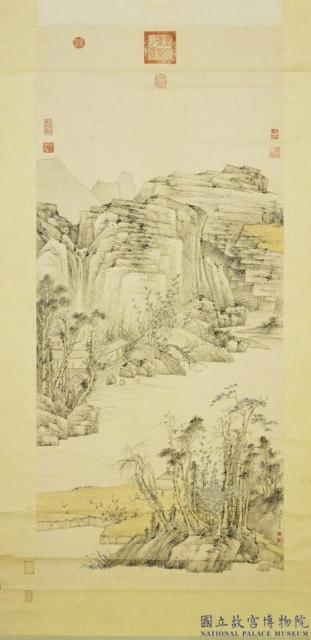清永瑢畫山水 軸
推薦分享
資源連結
連結到原始資料 (您即將開啟新視窗離開本站)後設資料
- 資料識別:
- 故畫002684N000000000
- 資料類型:
- 類型:繪畫
- 型式:靜態圖像
- 著作者:
- 永瑢
- 主題與關鍵字:
- 楊柳 水榭 梅(白.紅.蠟梅) 文玩(琴棋書畫) 傢俱(屏風) 亭 竹 瀑布 松
- 出版者:
- 數位化執行單位:國立故宮博物院
- 格式:
- 本幅 156.7x69.3公分、全幅 95公分
- 關聯:
- 石渠寶笈三編(延春閣),第五冊,頁2136&*故宮書畫錄(卷八),第四冊,頁114&*故宮書畫圖錄,第十二冊,頁267-268&*永瑢(西元一七四三─一七九0年),高宗第六子。封質莊親王,自號九思主人。工詩文,能書畫,山水師近人黃堅,而能自闢一途。 一壑兩岸,山崗對峙,院中老梅吐艷,為冬天點景。山石用側筆折帶皴,表現層石積疊之狀。復用乾筆橫臥點苔,顯現出蒼茫的氣氛。枯木疏林,平坡亭子,皆受倪瓚畫風影響。 &*Yung Jung(1743-1790)(tzu Chiu-ssu chü-jen)was the sixth son of the Ch’ien-lung emperor and was conferred the title of prince. He was a skilled poet, calligraphy and painter. Having taken the contemporary artist Huang Chien as a model for landscape painting, he developed an individual style. A river valley separates two hills which face each other. Inside the courtyard an ancient plum puts forth its first blossoms. In the mountains and rocks Yung first used a slanted brush to add che-tai ts’un(several-belt texture strokes)which give the appearance of the layer upon layer of thinly faceted rock. Later he employed a horizontal brush to add dry moss dots. The compositional elements-dry wood and withered trees, flat banks and a pavilion-where obviously derived from the paintings of the Yüan master Ni Tsan.
- 管理權:
- 國立故宮博物院
授權聯絡窗口
- 國立故宮博物院圖像授權、出版授權、影音資料授權-申請流程說明
http://www.npm.gov.tw/zh-TW/Article.aspx?sNo=03003061





